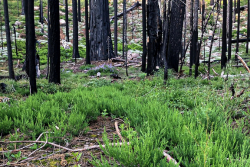Helicopters and landscaping don't belong in Sequoia NP Wilderness
Wilderness Watch is urging the National Park Service (NPS) to drop a proposal to potentially use helicopters and plant as many as 600,000 giant sequoia and other seedlings across 1,100 acres in the remote John Krebs and Sequoia-Kings Canyon Wildernesses in California. The proposed timeline is two weeks in Fall 2023-2025, but could extend into 2028. If this all sounds familiar, it’s because this latest proposal is an expanded version of a plan from last year that called for planting up to 12,000 seedlings on 48 acres within Wilderness.
The project area includes the Homers Nose, Board Camp, Dylan Wood, Redwood Mountain, Suwanee, and New Oriole Lake giant sequoia groves, all within Wilderness in Sequoia National Park. Board Camp and some of these other groves burned intensely in the 2020 Castle Fire, and the NPS fears that increasingly hot and dry conditions may prevent giant sequoias from naturally regenerating. The NPS is currently collecting giant sequoia cones and looking at regeneration on the ground, with a focus on the area with the lowest regeneration rate. While the proposal is somewhat unclear, the NPS might cut down trees so that helicopters can be used for transporting seedlings and tools. The agency doesn’t indicate the number of helicopter flights or whether helicopters will indeed be used.
The Wilderness Act prohibits manipulating Wilderness—like what the NPS proposes in this massive landscaping project—for good reason. Wilderness is meant to be shaped by natural processes, not gardened into what land managers want. Wilderness Act author Howard Zahniser put it best when he implored us to be “guardians not gardeners.”
The proposal violates the fundamental values of Wilderness, and is an example of how, when faced with the effects of climate change, land managers are increasingly looking to intervene in and manipulate Wilderness. Planting in Wilderness, regardless of how well intended, violates a fundamental tenet of Wilderness—that it remains “untrammeled,” or unmanipulated.
Helicopters are antithetical to Wilderness, and prohibited by the Wilderness Act, except in rare cases where such use is essential to wilderness protection or search and rescue operations. Helicopters harass wildlife and destroy the experience for wilderness visitors.
Instead of planting giant sequoia and other seedlings, possibly cutting down snags, and using helicopters in Wilderness, NPS should allow natural processes to continue to shape the Wilderness as they have for millennia. Not only is this the right thing to do for Wilderness, but it also presents a perfect opportunity to study natural regeneration in an area burned by a high, medium, and low-intensity fire.
Recently, a team of independent scientists reported that they are now finding thousands of naturally-regenerating sequoia seedlings per acre in the higher-intensity fire areas where NPS claims sequoia regeneration is lacking and artificial planting is supposedly needed. As a recent opinion-editorial in the Los Angeles Times explained, giant sequoias naturally reproduce best where higher-intensity fire has occurred. This research shows the Park Service's reasons are groundless.
Thank you to thousands of our members and supporters who urged the Park Service to drop this proposal to use helicopters, remove snags, and plant trees in the Wilderness during the recent comment period that ended in August 2023.
- Read our joint comments on the EA (8/2023)
- Read our joint comments (3/2023)
- Read our comments (3/2022)
Additional information
- Untrammeled: How a plan to replant giant sequoias unearths questions about the meaning of wilderness (KALW, July 2023)
- California’s iconic sequoias are being incinerated by wildfires. Should we save them? (San Francisco Chronicle, August 2023)
Photo: Giant sequoia natural regeneration in the Redwood Mountain Grove within the Sequoia-Kings Canyon Wilderness, one of the groves NPS claims is not regenerating and in need of artificial plantings. Photo by Dr. Chad Hanson.
Contact Us
Wilderness Watch
P.O. Box 9175
Missoula, MT 59807
P: 406.542.2048
Press Inquiries: 406.542.2048 x2
E: wild@wildernesswatch.org
Minneapolis, MN Office
2833 43rd Avenue South
Minneapolis, MN 55406
P: 612.201.9266
Moscow, ID Office
P.O. Box 9765
Moscow, ID 83843

